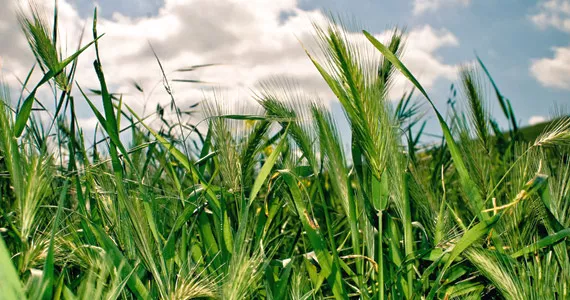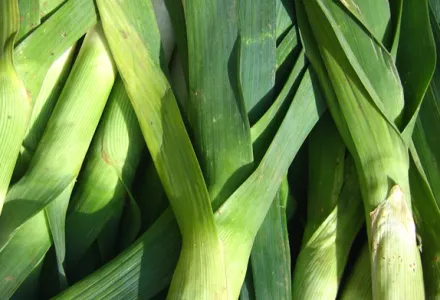Barley grass could well be called the superman amongst foods, the young emperor of health. A bright green supercop to ward off high cholesterol levels and even kill off carcinogens, we’re told. Not bad for a baby! Let us show you the wondrous world of barley grass. Let’s juice it!
Heaps of History

It must have been a massive, life-changing discovery about 9000 years ago when the inhabitants of what is now known as the Middle East started cultivating barley. Barley, or hordeum vulgare is derived from a wild species similar to Hordeum spontaneum, which is common occurs widely in Turkey and Syria. For the first time, man was able to grow a steady supply of food on the same spot. No more hunting. No more relentless travelling around. Barley was probably the first cereal grain to be cultivated by man. And since barley grass is nothing more than baby barley before the ovule has begun to move up and the grain started to develop, barley grass has actually been around even longer. written crop reports have been found in Egypt dating back to 2440 B.C.
Those Egyptians and also the Greeks, knew the importance of the plant they suspected it was a gift from the gods and revered it as a sacred grain. Its cultivation spread rapidly around the globe. The Chinese were cultivating barley in 2,000 B.C. and it was also one of the first crops to be planted in the new-world colony of Virginia in 1611.
In the Pulitzer Prize-winning book Guns, Germs, and Steel, Jared Diamond argues that the availability of barley, and barley grass, is one of the main reasons why Eurasian civilizations have survived and conquered others. Since biblical times, ancient Asian and Middle Eastern cultures reportedly included barley grass in their diets. Historically, the young plant species were used to treat the skin, the liver, the blood, and gastrointestinal disorders. Ancient Greeks used it to treat gastrointestinal inflammations. Gladiators in Rome ate barley grass for strength and stamina. The Roman physician Pliny used barley grass as part of a ritualized cure for boils.
Neatly nutritious
It took a while for science to get to the bottom of the nutritional value of barley grass and other cereal grasses, though. But in 1940, nutritionists finally explained how the vitamins, minerals, and protein in cereal grasses like barley grass are essential to animals and humans. The Council of Foods of the American Medical Association approved a dehydrated preparation of cereal grass called “cerophyl” as an “accepted food” in 1939.
The true nutritional benefits are found in the young grass leaves. These leaves contain many of the vitamins, minerals, and proteins necessary for the human diet. Barley grass is considered a whole food concentrate that is close to its natural state, supplying the nutrients we require in natural proportions.
So you want to know how nutritious baby barley is? Ready? The juice of barley grass contains eighteen amino acids including alanine, arginine, aspartic acid, glutamic acid, glycine, histidine, isoleucine, leucine, lysine, methionine, phenylalanine, proline, serine, threonine, tyrosine and valine. Amino acids like these are the building blocks of proteins, which are the major constituents of our body and necessary for the continuous processes of cell building, cell regeneration and energy production that are part of living. The vitamins found in barley grass include beta-carotene, folic acid, pantothenic acid, vitamin B1, vitamin B2, vitamin B6 and vitamin C. The minerals include potassium, calcium, magnesium, iron, copper, phosphorus, manganese and zinc. Along with all that, you get lots of live enzymes, one of which is the anti-aging enzyme called superoxide dismutase (SOD). SOD aids digestion and metabolism by helping to disperse vitamins and minerals into the blood stream so that they can be absorbed by the body. Neatly nutritious, no?

The green magic of chlorophyll
When you look at the pictures next to this article, the bright emerald green of the young grass splashes off the page. This colour reflects the abundance of chlorophyll in the plant, as in other dark leafy vegetables. Chlorophyll, which is an inherent component of all green plants, is very similar to haemoglobin. In fact, their molecular structure is nearly identical. This similarity makes it easy for the body to assimilate. Haemoglobin is substance that oxygen binds to in the blood to be carried around the body, and chlorophyll actually boosts the haemoglobin count in the blood. More haemoglobin means more oxygen-rich blood. So chlorophyll actually aids in the rebuilding of the blood stream. For example, animals with a low red blood cell count that were given wheat grass had a healthy level of red blood cells within five days. It also prevents bacterial growth in the digestive tract as well as the production of yeasts and fungi. Chlorophyll eliminates bad breath and acts as an internal body deodorant.
Chlorophyll and other essential nutrients act synergistically in barley grass to detoxify the body from destructive toxins such as the heavy metals and pollutants that we ingest every day. Chlorophyll also has anti-inflammatory properties.
Active antioxidant
But the health benefits don’t stop there. Barley grass is also an extremely powerful antioxidant. It has the ability to scavenge free radicals. Reactive oxygen species have been shown to play an important part in mediating the production of pro-inflammatory cytokines and can be instrumental in the pathogenesis of diseases such as rheumatoid synovitis, arthritis, and gout.
Anything else?
So, is that all? Almost. Research in Japan and other countries suggests that barley grass can also help against asthma, obesity, skin rejuvenation, anaemia, arthritis, gastritis, peptic ulcers, diabetes, cellular damage from x-rays, heart disease and hepatitis.
Chasing cancer
Are we done yet? Definitely not! The really big one is that barley grass protects human tissue cells against carcinogens. The exact mechanism at work is unknown but it may be associated with the plant’s antioxidant activity or its chlorophyll content. It has been suggested that complexes may be formed between the carcinogen and the chlorophyll that may de-activate carcinogens. In addition, antioxidants, including superoxide dismutase, found in high concentrations in green barley juice protect against radiation and free radicals.
The dreadful downside
So, what’s the catch? I mean, it can’t be all good can it? Well, you are right. There is a downside. Some taste buds might not appreciate the taste of the green, slightly bitter juice. That’s all? Yep, that’s all. There are absolutely no known side effects to this superfood. So, once again, let’s juice it for a healthier life!
Grow it yourself!
There is one other thing. Barley Grass powder is not cheap. However, it’s very simple to grow it yourself! Put barley seeds in water to accelerate germination. After 24 hours, put the seeds in soil in a pot. Put the pot in a warm and bright area to stimulate growing. Water the seeds daily. During 14 days, they will grow about 20 cm, with 100 grams of seeds producing about 100 grams of grass. Process the grass in a blender 100 - 200 grams of grass + 1/2 litre of water. Filter the juice and dilute it with 1/2 - 1 litre of water. Ready to go!
Smooth recipe for health
This green smoothie is loaded with nutrients and tastes great!
- 2 bunches of spinach
- 1 bunch mint leaves
- ½ peeled cucumber
- 1 cup fresh pineapple
- 1 cup frozen pineapple/peach/mango
- 2 large ripe pears
- 2 cups water
- 2.9 cl barley grass juice
Blend it and down it! To your health.










